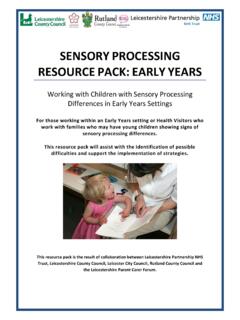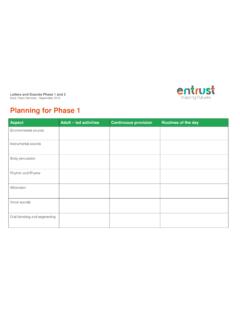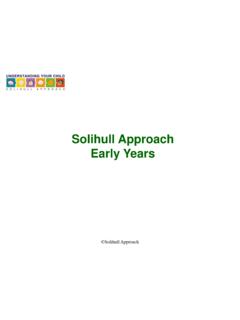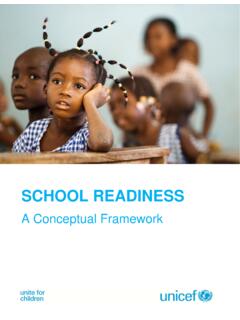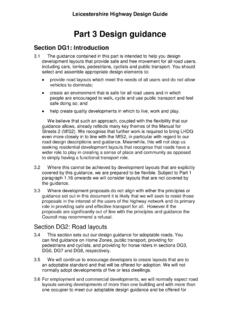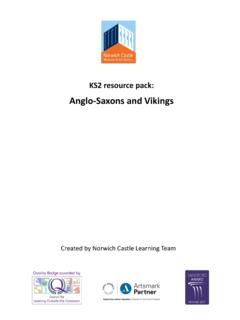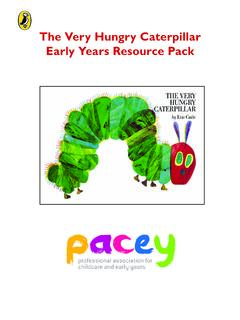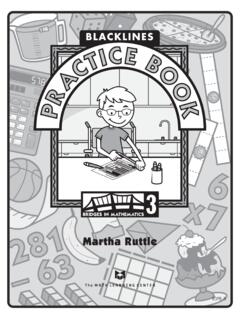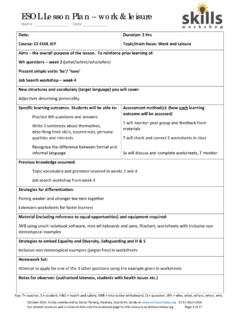Transcription of SENSORY PROCESSING RESOURCE PACK: FOR SCHOOLS …
1 SENSORY PROCESSING RESOURCE pack : FOR SCHOOLS KEYSTAGE 1- 4 Supporting Children with SENSORY PROCESSING Differences in school Settings Version 1 Jan 2014 Version 2 March 2014 Version 3 April 2014 Version 4 September 2015 SENSORY PROCESSING for SCHOOLS KS1-4 Sept 2015 1 Table of Contents Who is this RESOURCE pack for? .. 3 What is the purpose of the RESOURCE pack ? .. 3 Who has been involved in its development? .. 3 How to use this guide .. 3 What is SENSORY PROCESSING ? .. 4 Emotional, social and behavioural responses .. 6 Relationship between SENSORY PROCESSING , behaviour and rigidity? .. 7 Are SENSORY issues causing the behaviour? .. 8 Explanatory Notes .. 9 Working out which SENSORY system is involved and how to help .. 10 Tactile (touch) System .. 12 Supporting strategies .. 14 Taste And Smell .. 15 Visual System .. 17 Auditory (Sound) .. 20 Proprioception and Vestibular (Movement Systems) .. 24 Proprioception .. 24 Vestibular .. 26 Jargon buster page.
2 36 Further Support and Advice .. 37 Training .. 41 Additional Resources .. 42 Books .. 42 Organisations/Websites .. 42 References .. 43 Authors .. 44 SENSORY PROCESSING for SCHOOLS KS1-4 Sept 2015 2 Who is this RESOURCE pack for? For Teachers and Support Workers who work with families who may have children showing signs of SENSORY PROCESSING differences which affect their academic learning , peer relationships, mental health and emotional and physical wellbeing in SCHOOLS . What is the purpose of the RESOURCE pack ? This RESOURCE pack will assist with the identification of possible difficulties and support the implementation of strategies. Who has been involved in its development? This RESOURCE pack is the result of collaboration between Leicestershire Partnership NHS Trust, Leicestershire County Council, Leicester City Council, Rutland County Council and Parent representatives.
3 The strategies included in this pack should not be used to isolate the young person, most of the strategies can be implemented as whole school strategies which will help the school become a SENSORY friendly environment. Some of the strategies will be more specific to the young person using a supportive inclusion programme. You may also need to seek support from external specialist services such as Specialist Teaching Services or Occupational Therapy. Your school may be implementing commercially available programmes such as SENSORY circuits, How does your engine run, Tools for Teachers, Tools for Teens. It is important to remember that the International Coalition for Education in SENSORY Integration (ICE-SI) recommends that these programmes are carried out under the support of an Accredited SENSORY Integration Trained Occupational Therapist, Physiotherapist or Speech and Language Therapist. How to use this guide There are many techniques and activities that teachers and parents can use to aid the child with SENSORY PROCESSING differences to improve general overall functioning.
4 Use this guide to consider what behaviour or difficulty is being observed. Why this may be happening and look up strategies framework that may help support the child. Contacts and how to refer to other services if difficulties continue are provided on page 38. SENSORY PROCESSING for SCHOOLS KS1-4 Sept 2015 3 What is SENSORY PROCESSING ? SENSORY PROCESSING refers to how we use the information received by all of the senses within our body and from our environments. All of the information is integrated to give us an understanding of who we are, where we are and what is happening around us. When our senses are integrated correctly we are able to respond appropriately to the sensation. For example we will take off the itchy woollen jumper or we may take a deep breath to smell the flowers. What happens when a young person experiences SENSORY PROCESSING differently?
5 A young person with possible SENSORY PROCESSING disorders may have difficulty in figuring out what is happening inside and outside of their bodies. The SENSORY information their body is registering may not be accurate. Imagine how it might feel in the classroom pictures on the wall repeatedly grab your attention as their brain doesn t register that this has been seen before. The noise of the school bell is like someone screaming in your ear. When standing in the queue at lunchtime makes you on high alert just in case someone brushes past you as this is painful. Getting dressed for is very difficult as you cannot balance, and don t know where your hands are to put your jumper on when you can t see your hands. Your body doesn t provide adequate information as to where your arms and legs are so you need to move constantly to get that extra feedback. This is difficult in the class when you are supposed to sit still and write.
6 There seems to be some faulty wiring somewhere, most people get used to SENSORY PROCESSING for SCHOOLS KS1-4 Sept 2015 4 their own SENSORY preferences and make choices about their daily activities appropriate to them. Some people can t bear the touch of cotton wool. Some prefer quieter restaurants; some crave rollercoasters and theme parks. However, children tend to go with their instincts and may struggle to communicate how they feel, they may be disorganised in a world they can t quite make sense of. These children need support from those around them to learn strategies and consider their needs to make life just that little bit easier. Our senses are the building blocks for all other skills we learn and use in life: Everything we do relies on our central nervous system (our brain and spinal cord and nerves). Then we get all our information from our senses and their individual systems.
7 These senses provide our brain with all the information it needs to grow, learn and develop all of our actions, skills and preferences. Here is one way of understanding how important our senses are as they are the foundation for daily life. Adapted from Williams and Shellenberger (1994). Academic skills, daily living skills and behaviour Attention, language, eye-hand co-ordination, posture SENSORY motor development, body awareness, motor planning, two side co-ordination Senses: smell, touch, taste, auditory, visual, vestibular, proprioception, Central nervous system SENSORY PROCESSING for SCHOOLS KS1-4 Sept 2015 5 There are seven senses explained in this RESOURCE pack , Tactile, Taste, Smell, Vision, Auditory, Proprioception and Vestibular. Each sense has its own section which is divided into: A description of the SENSORY system.
8 What happens when a young person experiences this differently? Supporting strategies. Research shows that 20 % of the school age population have SENSORY PROCESSING difficulties that impact on their ability to do every day activities. You don t have to have a diagnosis of cerebral palsy, ADHD, or Autism to have SENSORY PROCESSING difficulties although they are more recognised with these diagnoses. Often we see bright children not achieving because they are struggling with SENSORY PROCESSING and then they can get labelled as bad . Emotional, social and behavioural responses Children who have difficulty regulating their SENSORY systems often show signs of difficulty regulating their emotions. This can be seen in temper tantrums, crying easily, unable to read signs of others, snapping for no apparent reason, hurt easily. Increased/decreased fear/anxiety. This is because the limbic system in the brain is responsible for learning , memory, eating and drinking behaviours, aggression sexual behaviour motivation and expression of emotion.
9 Its purpose is to integrate and co-ordinate out inner and outer world. Its links with all other SENSORY systems. It is important to be aware that children with SENSORY PROCESSING differences are likely to show emotional differences too. When faced with perceived threatening SENSORY stimuli, it is likely to evoke the flight or fight response too. Imagine if you dislike the touch of chalk so much that it evokes a gag reflex. You would want to avoid it; when you next come across chalk, you would become anxious with all the physical responses, varied heartbeat, sweating etc. This may be how some of your young people feel. Other indicators of SENSORY difficulties are the social, emotional and behavioural responses to SENSORY stimuli, which may include; Temper tantrums No sense of humour Cries easily Can t express emotions Uncooperative SENSORY PROCESSING for SCHOOLS KS1-4 Sept 2015 6 Anxious Poor self-confidence and self esteem Immaturity Avoids eye contact Overly affectionate Can t read body language Frustration Difficulty coping with changes in routine Relationship between SENSORY PROCESSING , behaviour and rigidity?
10 SENSORY PROCESSING Routine / Rigidity Behaviour We have a truly physical need in the body for sensation. PROCESSING is the way the body receives and interprets sensations from the body and from all environments Rigid ideas are safe/comforting Offers security May reduce anxiety Provide SENSORY feedback to prepare for task Prove to avoid task Response to SENSORY stimuli, usually form of communication to Indicate I want to avoid I need something I need to tell you something Also emotional learned responses. SENSORY PROCESSING for SCHOOLS KS1-4 Sept 2015 7 Are SENSORY issues causing the behaviour? Making SENSE of the situation Using this very simple strategy to help understand and address any challenging movement, when the question comes into your mind? Is it SENSORY or behaviour? How can I help my student? S Stop assess situation behaviour happens for a reason E Environment change?
